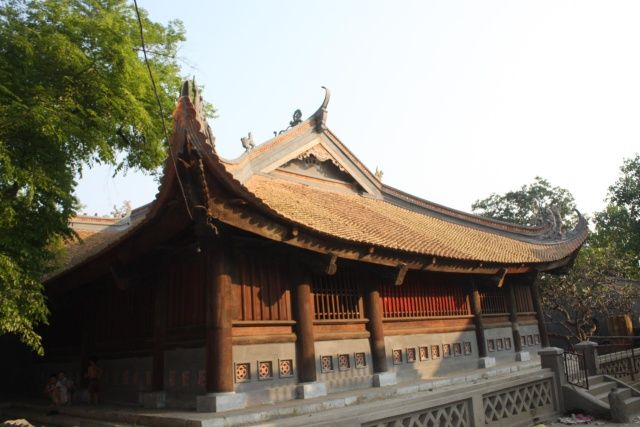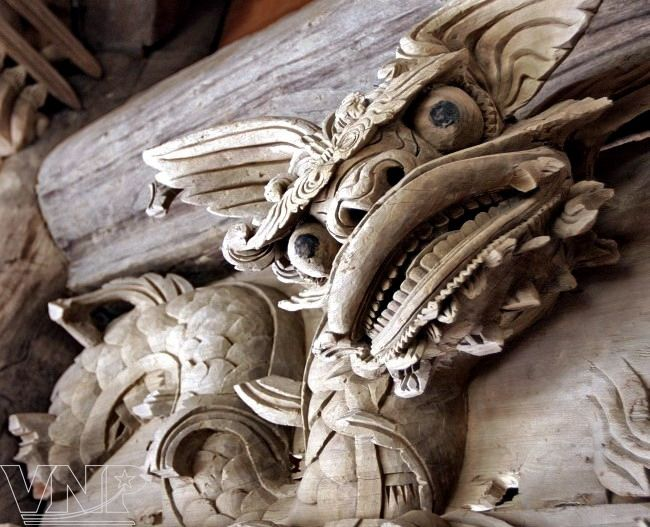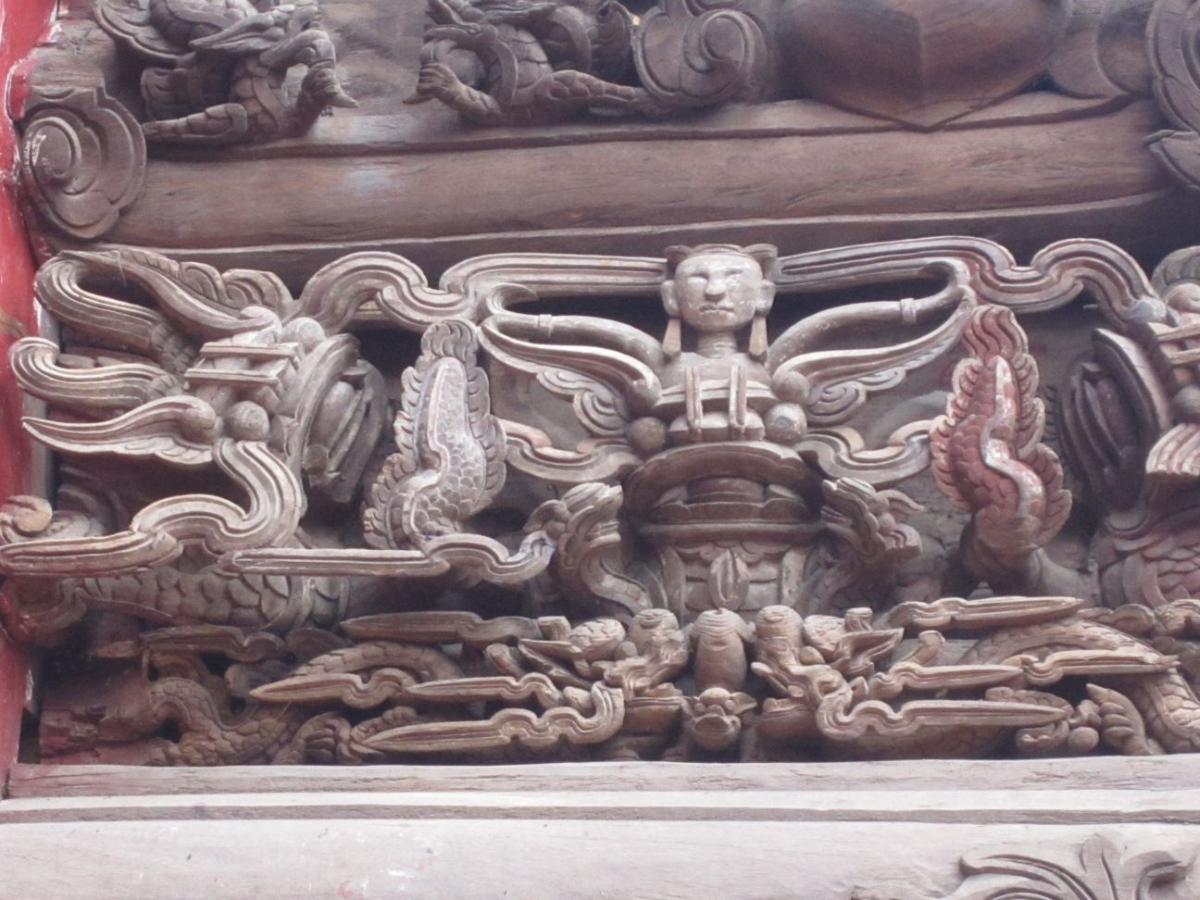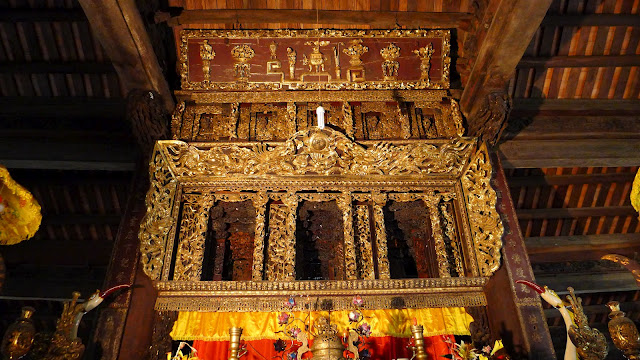Tho Ha communal house is located between Tho Ha village, Van Ha commune, Viet Yen district, Bac Giang province. The communal house was officially recognized as a national relic by the Ministry of Culture according to Decision No. 29/VH – QD signed on January 13, 1964.
Tho Ha communal house is a famous communal house of Kinh Bac, built in 1692, during the reign of King Le Hy Tong. Tho Ha communal house represents the spiritual and cultural space of the Vietnamese people with distinctive and unique architecture.
Tho Ha communal house is associated with the village’s tutelary god Thai Thuong Lao Quan. According to the legend of the village, he was a northerner, lived in the reign of An Duong Vuong, surnamed Ly, named Dam (also known as Lao Dam, Lao Tzu). He had the merit of killing the Xich Ty devil, opening a school and teaching in the village. He was conferred by the King as Thuong Dang god and Thanh Hoang Thai Thuong, allowing Tho Ha village to set up a temple to worship. Therefore, the villagers honored him as the Citadel, helping the villagers live a peaceful and happy life.
Architectural features
The communal house has a large scale, relatively complete architectural structure. The carvings show the style of the Le Dynasty clearly and uniquely. The theme shown on the main architectural elements is “four spirits, four precious” stylized flowers, birds, animals and people. The dragon in Tho Ha communal house is carved in many parts: residual head, trap, man, pole, plank, first sentence with themes of dragon nest, mother dragon carrying baby dragon, dragon and maiden…
Ancient curved roof
Tho Ha communal house currently consists of three houses: Tien Te, Dai Dinh and Hau Cung.
The sacrifice consists of 3 compartments and 2 wings located parallel to the Dai Dinh, a small distance from the Dai Dinh. The Great Communal House is connected to the harem by a pavilion, forming the shape of the word Cong. The money is made in the style of four curved roofs, roofed with comedy nose tiles, the roof and strip banks are attached to the lemon flower-shaped box.
Dai Dinh consists of 5 compartments and 2 wings, the main bearing component is a wooden frame consisting of 48 columns, of which there are 8 female columns, 16 military columns, and 24 porch columns.
The harem consists of 3 quite simple architecture. The harem is made in the style of “the back of the wall”, the two stages are decorated with the image of Tiger, the strip is made in the style of “long communal house”. This is a late 19th century architecture, popular in the late 19th century.
Decorative arts
A special feature in the decorative art of Tho Ha communal house is the Dai communal house. As for the front, the harem and the pipe, were built at a later stage, when the communal house was restored in the 18th – 19th centuries. In the Dai Dinh building, the art of decoration and sculpture shows its unique features through various themes with images of dragons, phoenixes, Nghe, unicorns, animals, flowers, clouds, fairies. . . The decoration has a common feature of strong lines, with high embossed blocks, with contrast between floating and sinking due to the virtuosity of carving techniques, talented and skillful craftsmen of the past and Most of the architectural elements of the communal house are touched such as in the structures: the Dou ke, the Ruong, the Ke, the Du head, the Nong board, the first sentence. . . For example, on the ends of Ke are decorated with dragon, rattan, and Nghe images and are carved on both sides, connected to plywood. The dragon in Ke patio appears quite unique with half of its body as if it had just come out of a column. The dragon’s head is outstretched, facing the roof, one leg of the dragon is on the pole, the other is playing with other animals. The dragon’s beard and the clouds flew backwards. Engraver faces also feature additional small animals. In particular, the knife holder in the corner of the western roof of the communal house has a long-beaked bird. The Nocs are also carved quite sophisticatedly with dragons, clouds, Nghe and flowers. In the two armpit beams of the western pavilion, the inner one is carved with a dragon image, the other one with an animal image. The carvings here are in the 16th century art style, with solid shapes, delicate carvings, and reliefs that are not high, but are almost spread on a different plane than the dragon carvings on the components. other in the style of the seventeenth century. Face up to support the roof, one leg of the dragon kicks on the pole, the other leg plays with other animals. The dragon’s beard and the clouds flew backwards. Engraver faces also feature additional small animals. In particular, the knife holder in the corner of the western roof of the communal house has a long-beaked bird. The Nocs are also carved quite sophisticatedly with dragons, clouds, Nghe and flowers. In the two armpit beams of the western pavilion, the inner one is carved with a dragon image, the other one with an animal image. The carvings here are in the 16th century art style, with solid shapes, delicate carvings, and reliefs that are not high, but are almost spread on a different plane than the dragon carvings on the components. other in the style of the seventeenth century. Face up to support the roof, one leg of the dragon kicks on the pole, the other leg plays with other animals. The dragon’s beard and the clouds flew backwards. Engraver faces also feature additional small animals. In particular, the knife holder in the corner of the western roof of the communal house has a long-beaked bird. The Nocs are also carved quite sophisticatedly with dragons, clouds, Nghe and flowers. In the two armpit beams of the western pavilion, the inner one is carved with a dragon, the outer one with the shape of an animal. The carvings here are in the 16th century art style, with solid shapes, delicate carvings, and reliefs that are not high, but are almost spread on a different plane than the dragon carvings on the components. other in the style of the seventeenth century. Engraver faces also feature additional small animals. In particular, the knife holder in the corner of the western roof of the communal house has a long-beaked bird. The Nocs are also carved quite sophisticatedly with dragons, clouds, Nghe and flowers. In the two armpit beams of the western pavilion, the inner one is carved with a dragon, the outer one with the shape of an animal. The carvings here are in the 16th century art style, with solid shapes, delicate carvings, and reliefs that are not high, but are almost spread on a different plane than the dragon carvings on the components. other in the style of the seventeenth century. Engraver faces also feature additional small animals. In particular, the knife holder in the corner of the western roof of the communal house has a long-beaked bird. The Nocs are also carved quite sophisticatedly with dragons, clouds, Nghe and flowers. In the two armpit beams of the western pavilion, the inner one is carved with a dragon image, the other one with an animal image. The carvings here are in the 16th century art style, with solid shapes, delicate carvings, and reliefs that are not high, but are almost spread on a different plane than the dragon carvings on the components. other in the style of the seventeenth century.
Dragon image is carved in the communal house
The carved flowers and animals also have many 16th century art styles with meticulous and delicate carvings creating valuable artistic features of the same time.
Sophisticated artistic architecture
* One-of-a-kind Hammock Door
At Tho Ha communal house, in addition to the decorations on the architectural department, there are other sculptures. It is a set of hammock doors in the middle space in front of the temple.
The hammock door is gorgeous and very elaborately made
The set of hammock doors made in the 13th year of Chinh Hoa (1692) are painted gilded, chiseled and carved very elaborately. The main part of the hammock door is 3 shrines. The altar is made in the style of 8 interlocking layers, the outer surface has a ledge carved with lotus petals and 6 small columns carved with dragons. Interspersed between the exams are 4 puzzles that touch the four quarters. The decorations on the hammock doors are mainly in the artistic style of the Le Dynasty (seventeenth century) but there are also some parts with the artistic style of the Nguyen Dynasty such as puzzles and paintings. The ornately carved golden hammock door makes the shrine even more dignified and ancient.
With architectural art bearing the architectural style of the 16th century, the scale and surface of the work also show the relatively high level of construction of the communal house by the workers in the past, bringing unique architectural values to the house. family. At the same time, the decorative sculptures in Tho Ha communal house are really works of art with carvings that are cleverly shown, beautiful and vivid lines than in the previous period. Along with the technical layout of carving, it also contributes significantly to the success of Tho Ha communal house decoration art. This is really considered the pinnacle of the art of decorating communal houses in the 17th century and deserves to be evaluated by scientists as a flower of the art of ancient architecture in Vietnam.
Source: Collected internet.



